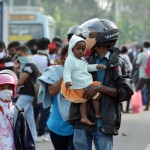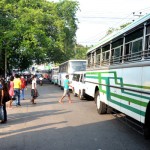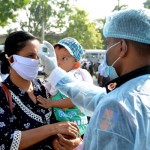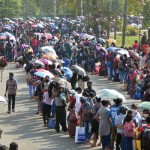News
Chaos as thousands crowd transport home for Free Trade Zone workers
Katunayake Free Trade Zone (FTZ) workers, many of whom had suffered great hardship in curfew lockdown, were finally able to return to their hometowns on Friday amidst chaos and crowds causing concern during a pandemic situation.
Organisations representing FTZ workers charge that a late measure of requesting hundreds of workers to gather for transport to their hometowns at a time when large gatherings are discouraged, increased the likelihood of the virus spreading.
Transport was by Sri Lanka Transport Board buses, with the military playing an active role in conducting health checks and accompanying the workers to be handed over to respective area police stations.
A senior official attached to the Ministry of Industrial Exports and Investment Promotion said plans had been made to transport about 1,500 FTZ workers to their homes.
When news got out that the government was providing transport to outstations during curfew time, some 5,000-8,000 people – including those employed in manpower agencies, construction and retail in the area – gathered near the Katunayake police station.
“Initially we ordered 80 buses to transport the garment workers but then, as the crowd gathered, another 70 buses were ordered from the SLTB to transport all of them to their hometowns,” the ministry official said, speaking on condition of anonymity.
“There were only two teams of military and healthcare personnel doing health checks using thermal scanners, but with the crowd increased we had to ask for another three health teams.
“After health checks the workers had to register at the Katunayake police station and obtain a pass before boarding buses, and this [with the unexpectedly large numbers now gathered] caused the chaos,” he said.
He added that all the workers had been transported home and Public Health Inspectors (PHI) in those areas had been instructed to make sure the workers and others go through two weeks of self-quarantine.
On Friday, the People’s Movement for a Free Health Service called for the Health Ministry to prevent the large gathering at the Katunayake FTZ, saying the event carried the risk of COVID-19 spreading.
Separately, the Free Trade Zones and General Services Employees Union asked the Minister for Labour to urge the Board of Investment of Sri Lanka (BOI) to supply dry rations to boarding houses and to ask companies to remit the salaries of employees.
“Because the government encouraged factories involved in export-oriented businesses to operate till the last moment, garment factories continued even while their overseas headquarters and retail shops were closed due to the pandemic,” the union’s Joint Secretary, Anton Marcus, said.
“While the private sector was asked to stay at home and work to prevent the spreading of the virus, factories continued with their work despite the employees’ protests.”
He said the Katunayake, Biyagama and Seethawaka FTZs have a total of 50,000 workers; by the end of this week there were about 20,000 at Katunayake.
“These workers stay in boarding places, some housing about 50-100 workers who have to cope with limited sanitation facilities. These cramped houses can’t be considered suitable for quarantine. We requested companies to remit their salaries, provide dry rations, and proper sanitation facilities. Some workers went hungry as shops around were shut down,” he said.
He said volunteer groups helped by Averiwatte police have been distributing dry rations and lunch packets during curfew hours.
According to Dabindu Collective, a rights group based in Katunayake, there are around 82 companies in the Katunayake FTZ servicing signature brands such as Gap, H&M, Marks and Spencer, Tommy Hilfiger, Decathlon and Victoria’s Secret.
“The majority of these workers are women and they reside in the boarding houses with their children, elderly parents and sometimes sick people too,” the Coordinator of the Collective, Chamila Thushari said. “It has been estimated that about 20,000 workers were in lockdown.”
She said about 500 construction workers employed at the airport were also staying in these boarding houses.
The Workers Struggle Centre wrote to Prime Minister Mahinda Rajapaksa about the crisis faced by factory workers confined to boarding houses during curfew who were starving as shops were shut down.
Amidst growing pressure, the decision was made to close down most of the BoI factories in the FTZ. The move followed a discussion with factory owners and Minister for Labour Prasanna Ranatunga this week.
“There are a handful of factories that are operating, with some involved in the production of safety wear. Strict guidelines have been provided including providing food, health checks, and safe boarding facilities for the workers,” the ministry official quoted earlier said.
On Friday evening, 39-year-old Sriyani Rajapaksa reached home in Kantale after days of struggle cramped up in a boarding house without dry rations to cook and food shops closed.
“I am finally at home with my family. Now I feel safe,” she said. “Even with two weeks’ quarantine ahead I know I won’t go hungry. The military made sure we were handed over to our local police stations and from there we were dropped off at our homes. This should have been done a week ago and would have prevented the hustle and bustle and gathering of thousands,” she said.
Additional reporting
by Deepa Adikari






